
Myrmecia is a genus of ants first established by Danish zoologist Johan Christian Fabricius in 1804. The genus is a member of the subfamily Myrmeciinae of the family Formicidae. Myrmecia is a large genus of ants, comprising at least 93 species that are found throughout Australia and its coastal islands, while a single species is only known from New Caledonia. One species has been introduced out of its natural distribution and was found in New Zealand in 1940, but the ant was last seen in 1981. These ants are commonly known as bull ants, bulldog ants or jack jumper ants, and are also associated with many other common names. They are characterized by their extreme aggressiveness, ferocity, and painful stings. Some species are known for the jumping behavior they exhibit when agitated.

The jack jumper ant, also known as the jack jumper, jumping jack, hopper ant, or jumper ant, is a species of venomous ant native to Australia. Most frequently found in Tasmania and southeast mainland Australia, it is a member of the genus Myrmecia, subfamily Myrmeciinae, and was formally described and named by British entomologist Frederick Smith in 1858. This species is known for its ability to jump long distances. These ants are large; workers and males are about the same size: 12 to 14 mm for workers, and 11 to 12 mm for males. The queen measures roughly 14 to 16 mm long and is similar in appearance to workers, whereas males are identifiable by their perceptibly smaller mandibles.
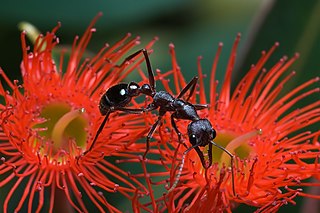
Myrmecia forficata, commonly known as the inchman ant, is a species of bull ant that is native to Australia. The ants are recorded in the south eastern part of the country, but are most common in the Australian Alps at elevations above 300m but can be found down to sea level around Melbourne and in Tasmania.

Myrmecia gulosa, the red bull ant, also known as the giant bull ant or "hoppy joe", is a species of bulldog ant from the genus Myrmecia. It is abundant throughout Eastern Australia.
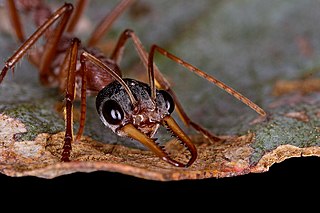
Myrmecia nigriceps, also known as the black-headed bull ant, is a species of ant endemic to Australia. A member of the genus Myrmecia in the subfamily Myrmeciinae, it was first described by Austrian entomologist Gustav Mayr in 1862. These ants are large, varying from 19 to 23 millimetres in length. However, colonies contain workers that are much smaller, usually half the size of normal workers. The queens are the largest while the males are the smallest, which can be easily identified due to their small mandibles.
Myrmecia pavida is a bull ant species that lives in and is native to Australia. Described by John S. Clark in 1951, the Myrmecia Pavida is distributed and has been mainly collected from the states of Western Australia and South Australia.

Myrmecia aberrans is an Australian bull ant of the genus Myrmecia. It is mostly spotted in South Australia and the states surroundings. The species of the bull ant was first described in 1900. The average length is around 12 millimetres. M. aberrans ants are commonly known as "wide jawed bull ants".

Myrmecia pyriformis, also known as the bull ant or inch ant, is an Australian ant. Myrmecia pyriformis belongs to the genus Myrmecia. It is abundant in many major cities of Australia, but mostly spotted in the eastern states. The species is of a similar appearance to the Myrmecia forficata.

Myrmecia nigrocincta, commonly known as the jumper ant or jumping jack, is an ant of the genus Myrmecia. The species was first described by Frederick Smith in 1858. Colonies of this ant are abundant in eastern Australia. Ants of this species are known for their ability to jump up to 10 centimetres, and they also have a powerful, venomous sting. Rather than foraging on the ground, M. nigrocincta prefer to forage in trees where they are known to pollinate certain flowers.

Myrmecia arnoldi is a bull ant of the genus Myrmecia. Like all bull ants except for one species in this genus, Myrmecia arnoldi is native to Australia.
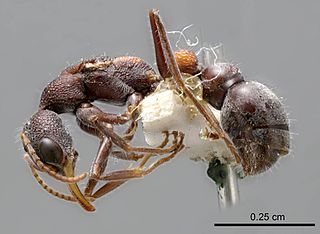
Myrmecia dichospila is an Australian ant which belongs to the genus Myrmecia. This species is endemic to Australia and is heavily distributed in South Australia and have some presence in other several states.
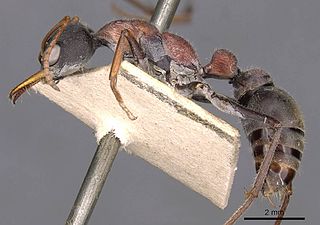
Myrmecia harderi is an Australian bull ant species which is part of the genus Myrmecia. They are native to Australia. They are mainly distributed in New South Wales, and some parts of Victoria, South Australia, and Queensland.

Myrmecia gilberti is an Australian ant which belongs to the genus Myrmecia. This species is native to Australia. This species is distributed throughout all of the eastern states and regions of Australia.

Myrmecia chasei is an Australian ant which belongs to the genus Myrmecia. This species is native to Australia. The Myrmecia chasei has a large presence and distribution in the south-eastern areas of Western Australia.
Myrmecia fulgida is an Australian ant which belongs to the genus Myrmecia. This species is native to Australia. Their distribution mostly in Western Australia and some areas of the east of Australia.
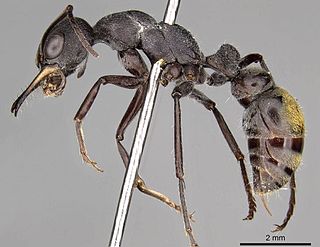
Myrmecia cydista is an Australian ant which belongs to the genus Myrmecia. This species is endemic to Australia. They are typically distributed in New South Wales and Queensland, and have been seen in several other states.

Myrmecia regularis is a species of ant endemic to Australia. A member of the genus Myrmecia in the subfamily Myrmeciinae, it was first described by American entomologist Walter Cecil Crawley in 1925. These ants are medium to large in size, measuring 10 to 20 millimetres, and they are bright brownish-red in colour. Queens and workers share similar morphological features, but they can be distinguished by the noticeable size difference. Males also look similar, but collected specimens are too damaged to be examined properly.

Myrmecia froggatti is an Australian ant which belongs to the genus Myrmecia. This species is endemic to Australia. This species is distributed throughout all areas of New South Wales and elsewhere up north and south.

Myrmecia tepperi is an Australian ant which belongs to the genus Myrmecia. This species is native to Australia. Their distribution is large in Western Australia, South Australia, and New South Wales.

















